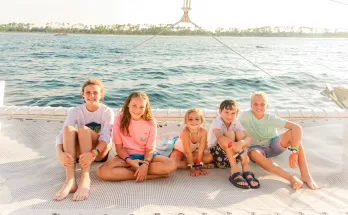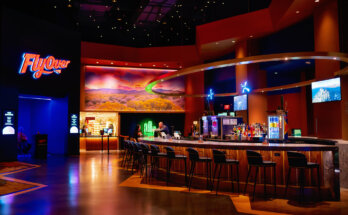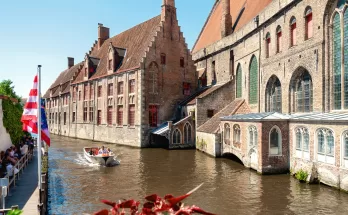We may earn money or products from the companies mentioned in this post. As an Amazon Associate, I earn from qualifying purchases.
Hi everyone! It’s Matt here.
As my inaugural blog post, I wanted to say hello to readers of Our Little Lifestyle! I know that this is something Sarah has poured her heart and soul into over the years and thank you for following along. I don’t often get time to write, but I wanted to add my voice to a site dedicated to our family and the adventures highlighting our journey together. Writing has always been a love of mine, but as is so often the case, real life has gotten in the way, and time is short for anything except raising children and going to work. I’m hopeful my few words of perspective can add a little something to the blog, or at a minimum, gives me a fun hobby that allows my creativity to flow and help my wife a bit. Enjoy!
5) Gold Panning in Alaska
Gold is a timeless treasure, an element that neither rusts nor tarnishes. It’s glimmer has entranced mankind since the dawn of history, and kings and queens have gone to the ends of the earth to find it. Some of the best gold searching can be done right here in the USA. Aside from California, Alaska has some of the best “placer” gold deposits. Placer gold is gold often found in streams and rivers. Gold panning with my kids, knee deep in the cool waters of a beautiful Alaskan stream, is a true goal of mine. I can’t imagine their excitement if they find glittering treasure in their pan, and I imagine my son yelling ”Dad, I got some!” A great basic gold panning kit can be found here.
Finding gold is not necessarily easy. You can’t just pan anywhere. Prospecting is allowed on only certain pieces of land. Private and public lands are designated for gold panning, and the cost ranges from free to $50. Here are some of the most popular spots to go to find the shiny stuff, at a low cost:
- Fairbanks, AK. Home to some of the most famous mining attractions in the state, Fairbanks has a range of locations for gold panning. Just north of Fairbanks, the countryside is dotted with hundreds of small backyard gold mining operations and thousands of gold mining claims notices.
- Hope, AK. Located in the Kenai Peninsula, Hope is a small town of about 200 people. You can do a demonstration-based gold tour at Indian Valley Mine a few miles south of Anchorage, then continue another hour onto Hope where you can pan in Resurrection Creek.
4) Hunting for diamonds at Crater of Diamonds State Park
When I was about 13 years old, my parents took me on a family trip to Crater of Diamonds State Park in Murfreesboro, Arkansas. The park is located above the remains of an old, inactive volcano crater that brought lots of diamonds to the surface millions of years ago. It was tremendous fun, scouring the ancient volcanic landscape to locate something shiny sparkling in the afternoon sun! I went looking after a big rainstorm, and much to my excitement became one of the lucky guests to find something glistening on the ground. I found a 1/2 carat white diamond, a thing of beauty, and the largest diamond discovered that day. It’s a trip that’s absolutely perfect for the family, especially rambunctious kids who love getting out and digging in the dirt a bit. It’s also inexpensive and fairly close to anywhere in the central US. I held onto that diamond for decades and had a ring custom made for Sarah on our 10th wedding anniversary.
More than 33,100 diamonds have been found by park visitors since the Crater of Diamonds became an Arkansas state park in 1972. Notable diamonds found at the Crater include the 40.23-carat Uncle Sam, the largest diamond ever unearthed in the U.S. Amenities include walking trails, picnic sites, 47 Class AAA campsites (50 Amp/30 Amp/Water/Sewer), 5 walk-in tent sites, a gift shop, Kimberlite Cafe (seasonal), and Diamond Springs Water Park (seasonal), which is a great place to cool off after a summer day of digging for diamonds.
Prices are $10 for adults and $6 for kids (ages 6-12).
3) Hiking in Yosemite National Park
Stretching 8 miles east to west and boasting some of the most iconic natural features of any national park, Yosemite is truly one of the wonders of the natural world. With haunting waterfalls, lofty cliff faces, and some of the most beautiful terrain imaginable, the park has become established as a “must see” for all adventure lovers, hikers, and outdoor enthusiasts. Here you’ll find the park’s most famous landmarks – Half Dome and El Capitan – as well as excellent hiking trails through the natural monuments. I can’t imagine a better trip with my family, exploring wild places, witnessing the might and power of nature, and building life-long memories in such a beautiful place. I imagine it would have been hard to really enjoy it with younger kids but the kids are growing up fast and can keep pace with the adults these days.
The park is busy in primetime with almost 4 million visitors per year, but with some pre-planning you can still enjoy solitude in the great outdoors. Yosemite is located in eastern central California in the United States. West of the park are the major cities of San Francisco and Sacramento, California. Southeast of the park is Las Vegas, Nevada. South of the park is Los Angeles, California.
A park pass costs $35/vehicle and is valid for seven days. Y ou also can purchase the Yosemite Pass for $70 for unlimited visits to the park for 12 months.
“As long as I live, I’ll hear waterfalls and birds and winds sing. I’ll interpret the rocks, learn the language of flood, storm, and the avalanche. I’ll acquaint myself with the glaciers and wild gardens, and get as near the heart of the world as I can.”
― John Muir
2) Exploring Mammoth Cave
Mammoth Cave is the worlds largest (that’s right, I said world’s largest!) cave with 400 miles of passages explored and mapped so far. The twisting turning labyrinth of underground passageways are a remarkable testament to the beauty of the underground world. The caves were first settled by early native Americans, and later by European settlers. The park was established as a national park on July 1, 1941, a World Heritage Site on October 27, 1981, and an international Biosphere Reserve on September 26, 1990. The cave is tremendously large, at almost twice the length of the next largest cave system located in Mexico. Exploring vast underground places makes us feel humble, reminds us that the surface world in only part of the story, and gives us perspective into the power of nature – above and below the surface. I can very much envision me and my family, especially our curious kids, winding our way through an underground adventure-land filled with strange creatures, stalactites and stalagmites, huge dark expanses, and mysterious streams.
Legend has it that the first European to discover Mammoth Cave was either John Houchin or his brother Francis Houchin, in 1797. While hunting, Houchin pursued a wounded bear to the cave’s large entrance opening near the Green River. In the 19th century the cave was largely used for mining calcium nitrate (used to make gunpowder). It was extensively surveyed and mapped in the early 20th century. Groups of wealthy donors came together to purchase sizable tracts of land for the establishment of a national park, which occurred officially in 1941.
The park is located in central Kentucky near the town of Brownsville. Admission to the national park is free. A fee is charged for camping and cave tours. Activities include cave tours, hiking, horseback riding, biking, picnicking, camping, backcountry camping, canoeing, fishing, and some of the most pleasurable driving in Kentucky. Mammoth Cave National Park’s overnight accommodations include campgrounds and hotel facilities.
1) Seeing the General Sherman Tree
The General Sherman Tree is the largest tree in the world and presides over the lush forests of Sequoia National Park located about 3.5 hours northeast of Los Angeles. I was able to go there with a friend last year and the trip was amazing and awe-inspiring. Sarah, Abby and Jake weren’t able to come, so I hope we can carve out time for another trip in the future! The tree is massive, standing 275 feet, width a base circumference of 36 feet. It’s a daunting figure, even among the giant sequoia around it.
The tree is estimated to be between 2,300-2,700 years old. Imagine that! It was a sapling around the time Samaria fell to the Assyrians and 20,000 Isrealites were taken into slavery, ending the Kingdon of Isreal. When it was 1000 years old, Constantine the Great died. His empire was divided into the Western Roman Empire and Eastern Roman Empire. When it was 2000 years old The Black Death (bubonic plague) spread throughout Europe, killing an estimated 75 million people.
The lifetime of such a tree is beyond comprehension. It dwarves our mortality, forces us to reconsider time, and makes us humble in the knowledge we are but a tiny part of the universe. Being in the presence of something so grand and ancient gives me a greater sense of purpose around raising kids. I am but a teacher and a guide for another generation, another group of shepherds of the natural world, whose lineage dates back almost indefinitely, and will hopefully extend for many centuries to come. The kids have this book which is a great resource for helping explain the actual depth and duration of a giant seqouia life alongside history.
Sequoia National Park is adjacent to Kings Canyon National Park in California’s southern Sierra Nevada mountains. It’s known for its huge sequoia trees, notably the General Sherman Tree dominating the Giant Forest. The underground Crystal Cave features streams and striking rock formations. Moro Rock is a granite dome offering sweeping park views. Nearby is the Tunnel Tree, a toppled tree cut to accommodate the road.
The park entrance fee is $35 for private vehicles and $20 for individuals on foot or on bike, and is valid for seven days in both Sequoia and Kings Canyon National Parks. The National Parks pass ($60) allows unlimited entry into all national park areas for one year.
FOLLOW
OurLittleLifestyle on Instagram | OurLittleLifestyle on Facebook
OurLittleLifestyle on Twitter | OurLittleLifestyle on YouTube







The diamond hunting in Arkansas is fun, even if you don’t find a diamond. After having explored lots of caves in America though I would have to say you picked the wrong one. Carlsbad Cavern is way cooler than Mammoth and the free fourth grader pass will get you in for free! Mammoth caves doesn’t just let you wander around, so you have to pay to go on a guided tour. Still fun, but it costs more and you only get a limited amount of time.
Hi Chris! Thanks so much for the suggestions! We will keep Carlsbad Cavern in mind!